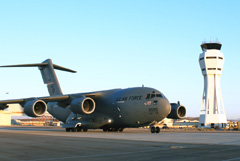
| C-17 Makes First
Flight on Synthetic Fuel Blend |
|
|
10/25/2007 - EDWARDS AFB, CA -- The Global Reach Combined Test Force began testing a C-17 Globemaster III using a Fischer-Tropsch synthetic fuel blend here Oct. 18. Flight tests began the following day and was the first time a C-17 was flown using the F-T fuel blend. Another test flight was conducted Monday as part of the Air Force's plans to certify the C-17 with F-T blended fuel and develop an overall process to certify all aircraft in the Air Force inventory with F-T fuel. "Our goal was to prove that the F-T fuel blend operates the same as JP-8 fuel with no adverse effects," said Maj. Scott Sullivan, 418th Flight Test Squadron, experimental C-17 test pilot. "We started out with ground testing, which involved running the auxiliary power unit and the running engines up to maximum take-off power. We then proceeded to flight tests and performed throttle transients at varying altitudes and air speeds." The natural gas blend of F-T fuel was mixed with JP-8, he said. It was essentially the same fuel blend used in the B-52H tests except for the manufacturer. The C-17 used a Shell blend, while the B-52 used a blend from Syntroleum Corp. "The only real difference between the B-52 tests and the C-17 is that we have more confidence now," said 1st Lt. Randy Anderson, 418th FLTS, propulsion engineer. "We know it worked on the B-52. From the cockpit, the C-17 seemed to fly the same as it would with JP-8 fuel. Now we have to go back and look at the test data to confirm that." During the first mission, the C-17 carried about 30,000 pounds of F-T fuel blend in one tank, he said. The other tanks were filled with standard JP-8. During the second mission, the C-17 carried a full load of F-T fuel blend, which weighed about 120,000 pounds. "In the first flight, we only operated one engine on F-T fuel blend for safety reasons," said Lt. Col. Bob Poremski, C-17 Integrated Test Team director. "This verified that the fuel worked and gave us a direct comparison between engines running JP-8 and F-T fuel." Major Sullivan said one of the greatest challenges to the flight testing was the test planning portion. "It was very challenging because we had to cover the full operational envelope of the C-17 in two flights and ensure we would get the data needed to eventually lead to certification," he said. "However, the flight tests themselves went very smoothly." One of the benefits of certifying F-T fuel is operational utility and flexibility to the warfighter, Major Sullivan said. "Being able to land in other countries and have more fuel sources available will greatly enhance the warfighter's use of the C-17," he said. "It will also carry our fuel reserves further into the future by being able to use alternate energy sources now." The C-17 has engines that are very similar to those used in multiple commercial aircraft, which is another important reason to certify the C-17 with the F-T fuel blend, Colonel Poremski said. "Certifying F-T fuel blends on the C-17 creates the potential that commercial carriers will look at alternative and synthetic fuels to burn in their fleet," he said. "This will ultimately reduce the amount of imported oil we burn in the United States and open up venues for other synthetic fuels." The Air Force plans to test and certify every airframe to fly on a domestically-produced synthetic fuel blend by early 2011. Source: USAF Edwards AFB Press Release by Senior Airman Jason Hernandez |
| |
